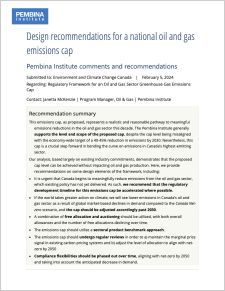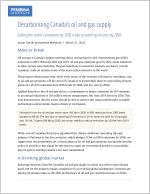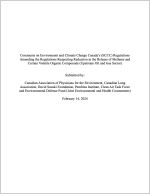
The Pembina Institute submitted these comments on the Regulatory Framework for an Oil and Gas Sector Greenhouse Gas Emissions Cap:
This emissions cap, as proposed, represents a realistic and reasonable pathway to meaningful emissions reductions in the oil and gas sector this decade. The Pembina Institute generally supports the level and scope of the proposed cap, despite the cap level being misaligned with the economy-wide target of a 40-45% reduction in emissions by 2030. Nevertheless, this cap is a crucial step forward in bending the curve on emissions in Canada’s highest-emitting sector.
Our analysis, based largely on existing industry commitments, demonstrates that the proposed cap level can be achieved without impacting oil and gas production. Here, we provide recommendations on some design elements of the framework, including:
- It is urgent that Canada begins to meaningfully reduce emissions from the oil and gas sector, which existing policy has not yet delivered. As such, we recommend that the regulatory development timeline for this emissions cap be accelerated where possible.
- If the world takes greater action on climate, we will see lower emissions in Canada’s oil and gas sector as a result of global market-based declines in demand compared to the Canada Net-zero scenario, and the cap should be adjusted accordingly past 2030.
- A combination of free allocation and auctioning should be utilized, with both overall allowances and the number of free allocations declining over time.
- The emissions cap should utilize a sectoral product benchmark approach.
- The emissions cap should undergo regular reviews in order to a) maintain the marginal price signal in existing carbon pricing systems and b) adjust the level of allocation to align with net-zero by 2050
- Compliance flexibilities should be phased out over time, aligning with net-zero by 2050 and taking into account the anticipated decrease in demand.
- We support the proposal that a facility’s use of the decarbonization fund should be limited to 10% of a facility’s GHG emissions for the initial compliance period, but recommend that this is phased down over time.
- ITMOs should not be accepted for compliance flexibility in the emissions cap.
- Decarbonization fund revenues should not be allocated to carbon capture projects. Instead, these revenues could be invested in innovative technology to increase the sector’s ability to decarbonize past 2030; to assist smaller facilities with monitoring and reporting requirements; or to support sustainable jobs.


